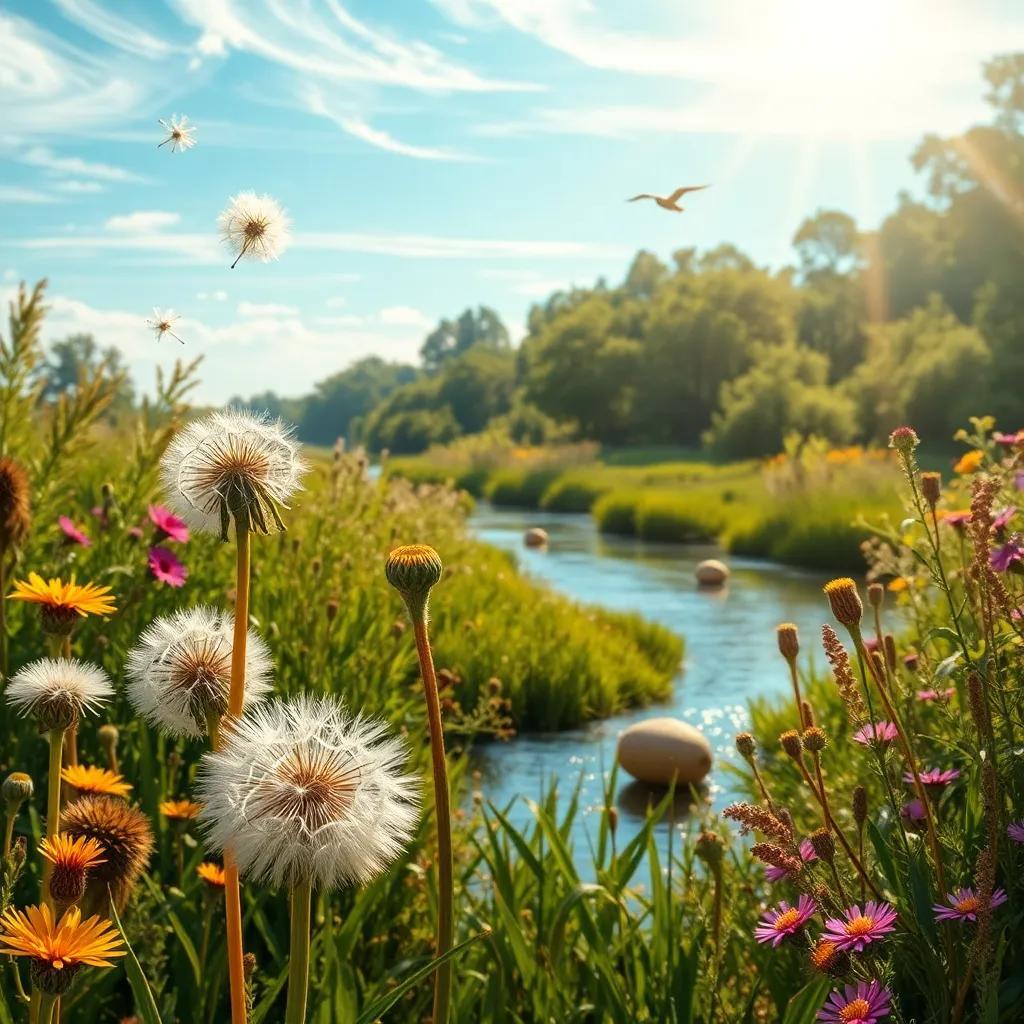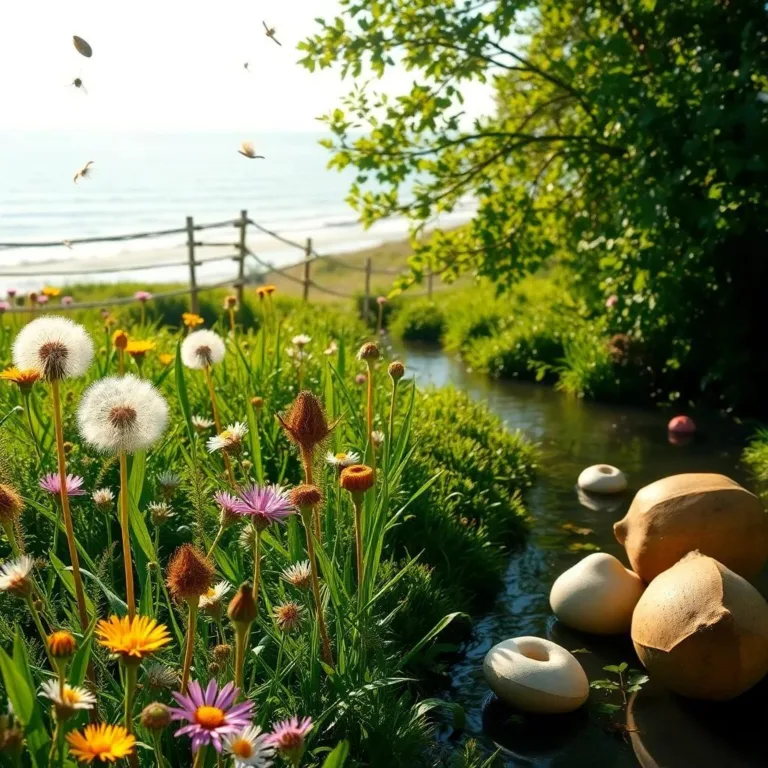Have you ever wondered how seeds travel to barren landscapes and bring new life? It’s like Mother Nature’s version of a road trip, and the seeds have some clever tricks up their sleeves! Join me as we explore the amazing ways seeds find their new homes, the animals that help them along the way, and the surprising role we humans play in this natural adventure!
Seed Dispersal Mechanisms in Nature
When I think about how seeds travel, it’s like a game of hide and seek! Seeds have all sorts of clever ways to get around, and they rely on nature’s help to find new homes. Let’s explore some of these fantastic seed dispersal mechanisms!
- Wind: Some seeds are light as a feather! They have special features like wings or fluffy tufts that catch the wind. When the breeze swoops in, these seeds can float away to new places, sometimes miles away! Think of dandelions—those little puffballs are tiny parachutes that spread their seeds with ease.
- Animals: Animals are like seed delivery trucks! Seeds can hitch a ride on their fur or feathers, thanks to sticky surfaces or spiky structures. When animals wander around, they drop these seeds in different locations. For example, the burdock plant produces burrs that cling to furry friends. Who knew animals could help plants with their travel plans?
- Water: Some plants prefer a splashy trip! They can float on rivers, lakes, or even puddles. Seeds with buoyant adaptations allow them to drift away from their parent plants. Coconuts are a perfect example—these sturdy seeds can ride ocean currents for thousands of miles!
- Humans: Believe it or not, we humans also play a role in seed dispersal! Sometimes, we accidentally carry seeds on our clothes or shoes, while other times, we intentionally plant them. Our gardening adventures can lead to new plant pals popping up all over our neighborhoods!
With these fascinating mechanisms, seeds can find their way to barren landscapes, where they can bloom and thrive. Isn’t it amazing how nature works its magic?
Animal Contributions to Seed Distribution
Animals are the MVPs (Most Valuable Players) when it comes to seed distribution! They help plants spread their seeds far and wide, making it possible for life to flourish even in the most barren landscapes. Let’s take a closer look at how animals participate in this important process!
- Endozoochory: This fancy term simply means that animals eat seeds and then… well, let’s just say they “deliver” them elsewhere! When birds munch on berries, for instance, they consume seeds too. Later, those seeds make their way through the bird’s digestive system. What happens next? The seeds are pooped out in a totally different spot, ready to grow into new plants!
- Epizoochory: Now, this one is like a free ride! Certain seeds have barbs or sticky coatings that allow them to cling to an animal’s fur or feathers. Picture a squirrel scurrying around with seeds stuck to its coat. As it hops from tree to tree, those seeds get dropped in new places, claiming new territory for their plant pals!
- Pollen Partners: Don’t forget about insects! Bees and butterflies help plants in more ways than one. While they are busy collecting nectar, they also transfer pollen from flower to flower. This process encourages the growth of fruits and seeds, helping plants to multiply!
It’s clear that animals play a significant role in helping seeds travel. Their movements create opportunities for new plants to flourish, and together, they form a vibrant ecosystem! Isn’t it wonderful how everything is connected?

Adaptations for Surviving Harsh Environments
Plants are a bit like superheroes in the way they adapt to survive in harsh environments! They have developed some amazing tricks to handle tough conditions, especially in barren landscapes where life can be quite challenging. Let’s explore some of these fascinating adaptations!
- Water Conservation: Many plants have learned to conserve water like pros! Some have waxy leaves that reduce moisture loss. Others develop deep root systems to reach underground water sources. For example, cacti have thick, fleshy stems that store water for dry times. It’s like having a built-in water bottle!
- Temperature Tolerance: Barren landscapes can experience scorching heat or freezing cold, but plants have their strategies! They might have tiny hairs on their leaves that provide shade or reflective surfaces that bounce away the sun’s rays. It’s like wearing a cool hat on a hot day!
- Nutrient Efficiency: Nutrient-poor soils are no problem for some plants! They have special root adaptations to maximize nutrient uptake. Some team up with helpful soil microbes to break down nutrients in their surroundings. It’s a plant party underground!
- Seed Dormancy: Some seeds are smart cookies! They can go into a state of dormancy, waiting for just the right moment to sprout. This helps them survive until conditions are perfect, like when the rains finally come. Talk about patience!
These adaptations show how resilient plants can be! They’ve learned to wear many hats, survive tough conditions, and thrive in places where it seems impossible. Isn’t nature just amazing?
The Role of Water in Seed Transportation
Water is not just for drinking; it plays a vital role in how seeds travel and find new places to grow! Known as hydrochory, this method of seed dispersal relies on bodies of water to carry seeds away from their parent plants. Let’s take a closer look at how this works!
- Buoyant Seeds: Some seeds are designed to float! They often have air-filled structures or light materials that keep them bobbing on the water’s surface. Think of water lily seeds; they can drift along rivers and lakes, finding a cozy spot to settle down.
- Natural Currents: Rivers, streams, and even ocean waves can carry seeds over great distances. This is super useful for plants that grow near water sources. When seeds float downstream, they can establish in new areas that might be more suitable for growth.
- Rainwater Transport: Heavy rains can wash seeds away from their parent plants and into the nearby waterways. This can be a great opportunity for seeds to travel to new homes, as they hitch a ride on the currents created by stormwater.
- Challenges of Water Dispersal: While water transportation has its perks, it isn’t always smooth sailing! Strong currents might wash seeds to unsuitable places, or they could get stuck in vegetation. But even with these challenges, many seeds find their way to new spots.
Water is a true ally for plants trying to spread their seeds! By using the power of water, seeds are given the chance to explore new environments and grow into beautiful plants. How cool is that?
Human Impact on Seed Dispersal Patterns
Humans have a significant influence on how seeds are spread around the globe! Our actions can either assist or hinder the natural processes of seed dispersal. Let’s take a closer look at the impact humans have on seed dispersal patterns!
- Intentional Planting: When we garden or farm, we actively plant seeds in new places. This intentional dispersal allows us to cultivate different plant species. It’s kind of like setting up a plant party in your backyard! Our choices affect the diversity of plant life in our surroundings.
- Unintentional Transport: Sometimes, we accidentally carry seeds with us! They can stick to our clothes, shoes, or even garden tools. When we travel to new areas, we might leave these seeds behind, introducing new plant species to places they’ve never been. Surprise, surprise!
- Urban Spread: Urban areas create perfect conditions for seeds to spread. Construction sites, roads, and landscaping projects can all lead to unintentional seed dispersal. This results in a mix of native and non-native plants existing side-by-side in cities, creating unique green spaces.
- Invasive Species: While some of our actions are beneficial, they can also lead to problems. Introducing non-native species can result in invasive plants taking over areas. These plants often outcompete native species, disrupting local ecosystems. It’s a delicate balance!
Understanding how our interactions with nature affect seed dispersal helps us make responsible choices! By being mindful of our gardening habits and travel, we can promote healthy ecosystems and preserve the beauty of our natural world. Together, let’s be good stewards of the environment!

